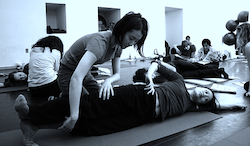It’s nearly Nutcracker season, and that may mean you have a couple gigs lined up to keep you busy and pay your bills. But what happens in January, when the gig is up? Is it back to waiting tables or baby-sitting?
Many dancers struggle with how to support themselves between freelance projects or contracts. But why not use that time – and your incredible body awareness and knowledge – to do something that’s somewhat related to dance, something that could even one day become a career once the shoes are hung?
For inspiration and insight, Dance Informa highlights three savvy women – all former dancers – who have created their own successful business based on a fitness form like Pilates and stretch, or a teaching practice such as yoga. With their advice, you, too, can learn what it takes to “be your own boss” and support yourself between dance gigs.
Teaching while dancing.

Steele Pilates Certification students. Photo courtesy of Teri Lee Steele.
Teaching is not only a way to pass on your knowledge and love of dance to others, but it can sometimes make you a better dancer yourself. When you teach, you begin to break things down and make realizations in ways that may even better inform your own technique.
TaraMarie Perri, founder of The Perri Institute for Mind and Body (home of Mind Body Dancer®, an alignment-based style of yoga), discovered that yoga and dance offered an interesting conversation, with each practice informing the other. Perri, who danced professionally in classical, contemporary and modern companies, and in theater and multi-disciplinary projects, practiced yoga actively throughout her career. She delved deeper into the traditions and benefits of yoga and knew she wanted to share that knowledge with others, especially dancers. While Perri doesn’t call teaching yoga a “back-up plan” but instead her life’s work, teaching yoga supported her as a dancer, both financially and in terms of managing stress and challenges. In 2009, she founded her own curriculum. Today, her students consist of a great deal of dancers, and her curriculum’s graduates have gone on to teach Mind Body Dancer® in performing arts schools and universities.
After graduating from University of California, Berkeley, with a BA in Exercise Physiology, Teri Lee Steele moved to NYC in 1991 to pursue dance work. She performed with contemporary modern companies, including the Kevin Wynn Collection, and also started her own company, Steeledance, with husband Oliver Steele in 1995. All while rehearsing and performing, Steele used her fitness education for work as a personal trainer, scheduling clients in the mornings and evenings. In 2000, she became certified in Pilates and, after having her first child, used teaching Pilates to dancers to stay connected to the dance community. Having been injured before, Steele sought to share that Pilates could be a preventative way for dancers to stay stronger, and injury- and pain-free. She soon started her own Steele Pilates Certification program and Continuing Education Courses, and teaches clients independently as well as group classes at Steps on Broadway and elsewhere.

Donna Flagg teaching Lastics. Photo courtesy of Lastics.
Donna Flagg, creator/founder of Lastics, a stretching technique, graduated from Rutgers University’s Mason Gross School of the Arts with a degree in dance but says she always loved teaching more than performing. When a bad knee injury interrupted her dance career, Flagg started to rethink the way her body had been trained. The result was Lastics, which Flagg has since taught at the Joffrey Ballet School, New York Health and Racquet Club, Steps on Broadway and more. All of Flagg’s teaching has enabled her to build her own brand, which also includes a line of natural, handmade products that cater to dancers and those in fitness.
Starting out.
Teaching can be a great way to pay the bills and to stay in the movement realm. But Perri advises dancers to truly make sure they want to teach before diving in. “My advice to my students who I mentor is to discover what skills and interests they uniquely have when looking to support themselves,” Perri says. “It is usually something that makes their heart beat. If teaching movement, yoga or working in therapeutic modalities interests, it is a worthy endeavor, and there is much room to grow and many options to consider.”
Of establishing her own Pilates curriculum, Steele says, “I was very motivated by the idea of getting dancers ways of funding their dance lives through movement versus jobs which might poorly affect their body physically or self-esteem by working for tips in restaurants.”
A great way for dancers who are interested in forming their own movement/fitness-based work to get started is often certification. Steele offers a Pilates Mat Certification about two to three times per year at Steps on Broadway, for example, which enables graduates to teach private mat sessions or group classes. They are prepared to create client-specific sessions and can then go on to pursue any Pilates apparatus certification later on.

TaraMarie Perri. Photo by Sophie Kuller.
Other forms require certification, too, such as Zumba, barre classes, yoga and more. But Flagg also says it’s possible for dancers to design their own class and try to sell it into a gym, school or dance studio.
Once certified, having a mentor can be helpful in offering guidance in finding places to substitute or teach, and in seeking out clients. And make use of the dance community – post your services on Facebook or a dance studio’s bulletin board. Perhaps offer discounted rates to dancers. Eventually, word of mouth could serve you well.
Be your own boss.
Being a teacher and making your own schedule can be exhausting, frustrating at times. There’s no paid vacation, sometimes no health benefits or retirement savings plan. “You have to be very diligent and organized in terms of saving,” Steele warns.
And starting a company like these three ladies have requires a lot of work. “It requires a tremendous amount of resources, both in time and money,” Flagg says. “I work constantly because, beyond the classes I teach every day, there is so much that goes into tending to the needs of the business and our customers.”
But you also get to make your own schedule, which allows you to carve out the time needed for classes, auditions and rehearsals. And, as working dancers, that becomes very valuable.

Teri Lee Steele leading Pilates students. Photo courtesy of Steele.
In addition, teaching Pilates, stretch, yoga and the like keep you surrounded by the dance and movement community. “I love that I am doing something that allows me to constantly move,” Flagg adds. “But I love best of all that my technique helps people feel better in their body – or, in the case of dancers, helps them dance.”
For more information on TaraMarie Perri, Teri Lee Steele and Donna Flagg, visit their respective website: www.perriinstitute.com, www.teristeelepilates.com and lastics.com.
By Laura Di Orio of Dance Informa.
Photo (top): Donna Flagg teaching Lastics. Photo courtesy of Lastics.















